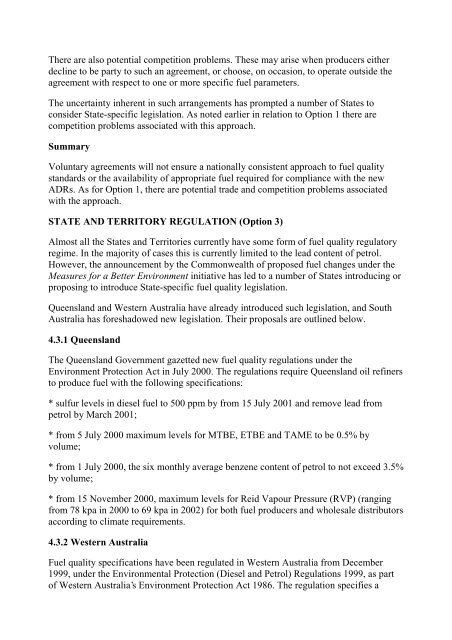National Fuel Quality Standards Regulation Impact Statement 1 ...
National Fuel Quality Standards Regulation Impact Statement 1 ...
National Fuel Quality Standards Regulation Impact Statement 1 ...
Create successful ePaper yourself
Turn your PDF publications into a flip-book with our unique Google optimized e-Paper software.
There are also potential competition problems. These may arise when producers either<br />
decline to be party to such an agreement, or choose, on occasion, to operate outside the<br />
agreement with respect to one or more specific fuel parameters.<br />
The uncertainty inherent in such arrangements has prompted a number of States to<br />
consider State-specific legislation. As noted earlier in relation to Option 1 there are<br />
competition problems associated with this approach.<br />
Summary<br />
Voluntary agreements will not ensure a nationally consistent approach to fuel quality<br />
standards or the availability of appropriate fuel required for compliance with the new<br />
ADRs. As for Option 1, there are potential trade and competition problems associated<br />
with the approach.<br />
STATE AND TERRITORY REGULATION (Option 3)<br />
Almost all the States and Territories currently have some form of fuel quality regulatory<br />
regime. In the majority of cases this is currently limited to the lead content of petrol.<br />
However, the announcement by the Commonwealth of proposed fuel changes under the<br />
Measures for a Better Environment initiative has led to a number of States introducing or<br />
proposing to introduce State-specific fuel quality legislation.<br />
Queensland and Western Australia have already introduced such legislation, and South<br />
Australia has foreshadowed new legislation. Their proposals are outlined below.<br />
4.3.1 Queensland<br />
The Queensland Government gazetted new fuel quality regulations under the<br />
Environment Protection Act in July 2000. The regulations require Queensland oil refiners<br />
to produce fuel with the following specifications:<br />
* sulfur levels in diesel fuel to 500 ppm by from 15 July 2001 and remove lead from<br />
petrol by March 2001;<br />
* from 5 July 2000 maximum levels for MTBE, ETBE and TAME to be 0.5% by<br />
volume;<br />
* from 1 July 2000, the six monthly average benzene content of petrol to not exceed 3.5%<br />
by volume;<br />
* from 15 November 2000, maximum levels for Reid Vapour Pressure (RVP) (ranging<br />
from 78 kpa in 2000 to 69 kpa in 2002) for both fuel producers and wholesale distributors<br />
according to climate requirements.<br />
4.3.2 Western Australia<br />
<strong>Fuel</strong> quality specifications have been regulated in Western Australia from December<br />
1999, under the Environmental Protection (Diesel and Petrol) <strong>Regulation</strong>s 1999, as part<br />
of Western Australia’s Environment Protection Act 1986. The regulation specifies a
















